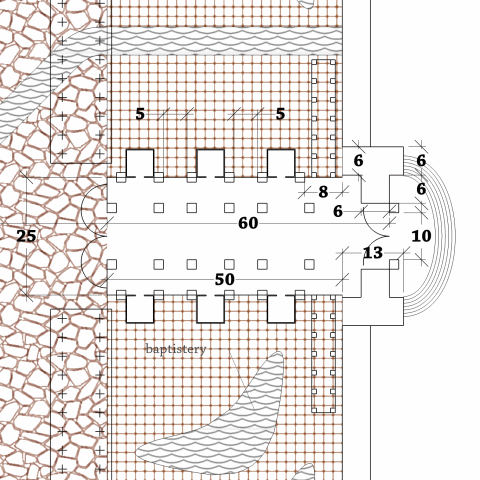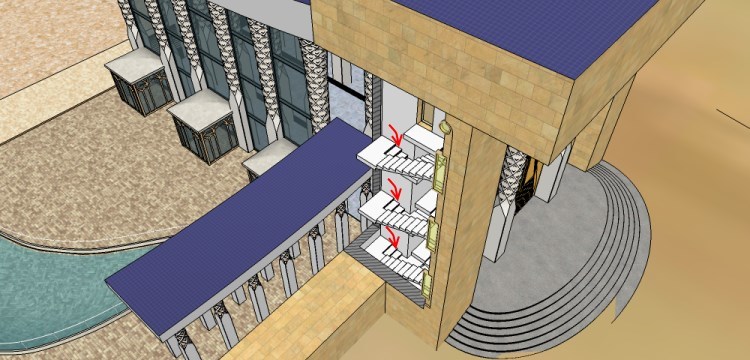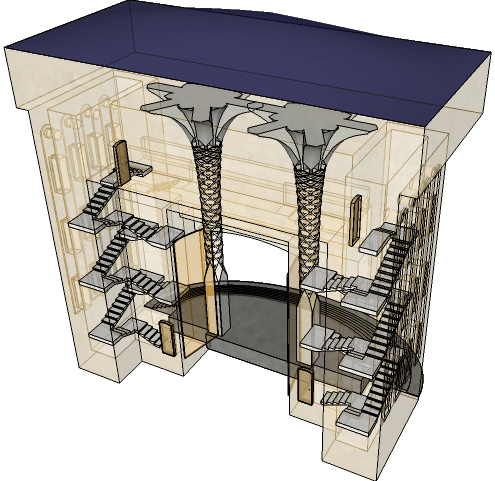The change refers to the interpretation of certain sizes of gates set in the prophecy of Ezekiel. The reason for revising the model was the unsatisfactory appearance of the front facade of the outer gates of the temple complex.
And he measured the width of the gateway, ten cubits, and the length of the gate, thirteen cubits. (Ezekiel 40:11)
So, length is length, and it can not be interpreted as the width of the space inside the pillars. Thus, the width of the space behind the pillars is equal to the width of the passage (10 cubits) plus the width of the pillars (2 + 2 cubits). Pillars do not go into the wall.
Pillars should not cover the front surface of the "threshold" of the gate, otherwise this "threshold" could not be measured in the sight of Ezekiel. The only acceptable position of the posts in relation to the wall of the gate is the position of the corner to the corner.

He made the side pillars sixty cubits high; the gate extended round about to the side pillar of the courtyard. (Ezekiel 40:14 – NASB)
He made also posts of threescore cubits, even unto the post of the court round about the gate. (Ezekiel 40:14 – KJV)
Interpretation of the 14th verse has not changed: in the original there is no word "height", this is the measurement of the distance between the outer and inner doors of the gate. In addition, there are 2 more options for interpreting the length of 60 cubits: as the length between the front and back pairs of pillars on which the doors hang, or as the full length that all the pillars in the gate occupy.
In one case, the pillars and the section of the wall of the gate with a size of 6 x 6 cubits should be moved inward by 2 cubits, in another case, the pillars and the section of the wall should be pushed outward by 2 cubits and thus the size of 13 cubits will be broken. In the case of the first option, there may be problems with the placement of internal staircases.
In three places it will not be possible to place three steps, there should not be single steps, so it will not be possible to collect the required number of steps to the height between the floors:

It seems to me that the measurement of 60 cubits is most logical between the gate leafs, so I did not change the old way of measuring 60 cubits.
In addition to the mentioned modification of the 3D model, there are other improvements.
The model is available for download.

And he measured the width of the gateway, ten cubits, and the length of the gate, thirteen cubits. (Ezekiel 40:11)
So, length is length, and it can not be interpreted as the width of the space inside the pillars. Thus, the width of the space behind the pillars is equal to the width of the passage (10 cubits) plus the width of the pillars (2 + 2 cubits). Pillars do not go into the wall.
Pillars should not cover the front surface of the "threshold" of the gate, otherwise this "threshold" could not be measured in the sight of Ezekiel. The only acceptable position of the posts in relation to the wall of the gate is the position of the corner to the corner.

He made the side pillars sixty cubits high; the gate extended round about to the side pillar of the courtyard. (Ezekiel 40:14 – NASB)
He made also posts of threescore cubits, even unto the post of the court round about the gate. (Ezekiel 40:14 – KJV)
Interpretation of the 14th verse has not changed: in the original there is no word "height", this is the measurement of the distance between the outer and inner doors of the gate. In addition, there are 2 more options for interpreting the length of 60 cubits: as the length between the front and back pairs of pillars on which the doors hang, or as the full length that all the pillars in the gate occupy.
In one case, the pillars and the section of the wall of the gate with a size of 6 x 6 cubits should be moved inward by 2 cubits, in another case, the pillars and the section of the wall should be pushed outward by 2 cubits and thus the size of 13 cubits will be broken. In the case of the first option, there may be problems with the placement of internal staircases.
In three places it will not be possible to place three steps, there should not be single steps, so it will not be possible to collect the required number of steps to the height between the floors:

It seems to me that the measurement of 60 cubits is most logical between the gate leafs, so I did not change the old way of measuring 60 cubits.
In addition to the mentioned modification of the 3D model, there are other improvements.
The model is available for download.
